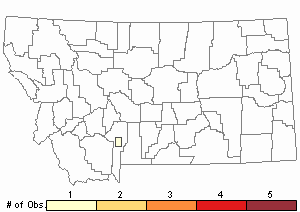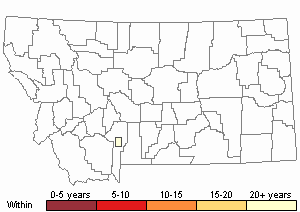View in other NatureServe Network Field Guides
NatureServe
Montana
Utah
Wyoming
Idaho
Wisconsin
British Columbia
South Carolina
Yukon
California
New York
Carolina Ground Cricket - Eunemobius carolinus
General Description
The following comes from Fulton (1931), Alexander (1957), Vickery and Kevan (1985), Bland (2003), and Himmelman (2009). In the early literature, the genus of this species was formally designated as Nemobius, as were the Allonomobius species. The Carolina Ground Cricket is a small, shiny, and somewhat flattened species with a head wider than its pronotum (thorax). The pronotum is one-third wider than its length and narrows toward its front. The body color is uniformly dark brown to black, with legs paler than the body, usually gray to yellowish-brown. The posterior margins of the wings (tegmina) are glossy, rounded at the tips, and cover three-fourths of the abdomen in males, and two-thirds in females. Some individuals, especially females, possess long wings [macropterous] which extend beyond the abdomen.
Calling Song description
The song is relatively loud for such a small cricket, but locating a singer can be difficult. The calls have been described by various authors as “a continous trill…with an alternation of two types of trills, one smooth, the other pulsating…” (Alexander 1957). “The song is a rhythmical, wavering trill with a slightly buzzy sound” (Bland 2003). “…stridulation takes the form of a wavering continuous trill made up of two types of pulse sequence, smooth and even, together with periodic de-emphasized faster pulses; during the even sequences there are 83 wing strokes per second…” (Vickery and Kevan 1985). “The song…reminds one of the distant droning of some species of Cicadas…a low buzz with a thin shrill overtone…If one listens to a single song closely, the beat will be found to die out and the song will run along at a reduced volume, sometimes seeming about to die out. Then it will gain in force again and tremble as before…No special mating song has been observed…” (Fulton 1931). “A rapid, buzzy trill with a stumbling or sputtering quality, as if the singer is never quite able to get on track. This wavering quality is due to slight variations in loudness as well as pulse rate” (Elliott and Hershberger 2007).
Phenology
This species overwinters in the egg stage. It occurs in the adult stage from mid-July into the first week of November, often exceeding the longevity of
Allard's Ground Cricket (
A. allardi). They are considered to be very cold tolerant and the last Orthopteran singing until the icy grip of winter occurs (Bland 2003, Himmelman 2009, Vickery and Kevan 1985).
Diagnostic Characteristics
The following is taken from Fulton (1931), Alexander (1957), Vickery and Kevan (1985), Bland (2003), and Himmelman (2009). The body size is 7-8 mm for males and 6-8 mm females. Female ovipositor is less than 3.5 mm. Tibial spurs of males are equal in length.
The Carolina Ground Cricket can be confused with any of the Ground Crickets in the genus Allonomobius.
Range Comments
The Carolina Ground Cricket is widely distributed from the west coast to the east coast of the U.S. and the southern portions of the eastern Canadian Provinces to Nova Scotia. It is absent in the northwestern U.S. and the western provinces of Canada. However, a very narrow “finger” of distribution extends from the eastern edge of the Dakotas, across the middle of South Dakota and the southern border of Montana, terminating at the Rocky Mountain front. There are no county reports for Wyoming. It is widely distributed species from the standpoint of plant associations and the most important factor controlling its distribution seems to be moisture. In Montana, this species has been reported for 3 southern border counties (Vickery and Kevan 1985, Walker's SINA website 2020).
Observations in Montana Natural Heritage Program Database
Number of Observations: 1
(Click on the following maps and charts to see full sized version)
Map Help and Descriptions
Relative Density

Recency


 (Observations spanning multiple months or years are excluded from time charts)
(Observations spanning multiple months or years are excluded from time charts)
Habitat
The Carolina Ground Cricket inhabits many types of damp habitats such as grassy areas of meadows, edges of lakes and streams, under stones and debris, around foundations of houses, decayed logs and in Sphagnum moss (not in Sphagnum bogs) (Bland 2003, Vickery and Kevan 1985).
Food Habits
There is insufficient specific data available, other to than to suggest probably similar to that of the Allonemobius species in this Field Guide.
Reproductive Characteristics
This species differs from the Allonemobius species in several ways. First, the male stands in front of the female but faces away from her during the courtship phases. Antennation by the female keeps the male stationary. The antennation of the female by the male only occurs occasionally, usually during their first encounter or when she is being pursued after leaving the male’s vicinity. Next, males “dance” by jerking and swaying in front of the female for a longer time period prior to the first mounting. This is followed by the first mounting, the pairs couple and jump together violently, remaining mounted and connected end to end for about 20 seconds. Next, the spermatophore does not hang downward but is tucked up against the venter of the male’s abdomen during courtship. The male stridulates almost continuously during courtship. Lastly, the second mounting is the time of spermatophore transfer (Mays 1971).
Stewardship Responsibility
References
- Literature Cited AboveLegend:
 View Online Publication
View Online Publication Alexander, R.D. 1957. The song relationships of four species of ground crickets. The Ohio Journal of Science 57(3):153.
Alexander, R.D. 1957. The song relationships of four species of ground crickets. The Ohio Journal of Science 57(3):153. Bland, R.G. 2003. The Orthoptera of Michigan—Biology, Keys, and Descriptions of Grasshoppers, Katydids, and Crickets. East Lansing, MI: Michigan State University Extension, Bulletin E-2815. 221 p.
Bland, R.G. 2003. The Orthoptera of Michigan—Biology, Keys, and Descriptions of Grasshoppers, Katydids, and Crickets. East Lansing, MI: Michigan State University Extension, Bulletin E-2815. 221 p. Elliott, L. and W. Hershberger. 2007. The songs of insects. New York, NY: Houghton Mifflin Harcourt. 227 p.
Elliott, L. and W. Hershberger. 2007. The songs of insects. New York, NY: Houghton Mifflin Harcourt. 227 p. Fulton, B.B. 1931. The study of the genus Nemobius (Orthoptera:Gryllidae). Annals of the Entomological Society of America 24(2).
Fulton, B.B. 1931. The study of the genus Nemobius (Orthoptera:Gryllidae). Annals of the Entomological Society of America 24(2). Himmelman, J. 2009. Guide to Night-Singing Insects of the Northeast. Mechanicsburg, PA: Stackpole Books. 160 p.
Himmelman, J. 2009. Guide to Night-Singing Insects of the Northeast. Mechanicsburg, PA: Stackpole Books. 160 p. Mays, D.L. 1971. Mating behavior of Nemobiine Crickets-Hygronemobius, Nemobius, and Pteronemobius (Orthoptera:Gryllidae). Florida Agricultural Experiment Station Journal 54(2):113-126.
Mays, D.L. 1971. Mating behavior of Nemobiine Crickets-Hygronemobius, Nemobius, and Pteronemobius (Orthoptera:Gryllidae). Florida Agricultural Experiment Station Journal 54(2):113-126. Vickery, V. R. and D. K. M. Kevan. 1985. The grasshopper, crickets, and related insects of Canada and adjacent regions. Biosystematics Research Institute, Ottawa, Ontario. Publication Number 1777. 918 pp.
Vickery, V. R. and D. K. M. Kevan. 1985. The grasshopper, crickets, and related insects of Canada and adjacent regions. Biosystematics Research Institute, Ottawa, Ontario. Publication Number 1777. 918 pp. Walker T.J.(ed.). 2020. Singing insects of North America. Accessed 10 February 2021. https://orthsoc.org/sina/
Walker T.J.(ed.). 2020. Singing insects of North America. Accessed 10 February 2021. https://orthsoc.org/sina/
- Additional ReferencesLegend:
 View Online Publication
View Online Publication
Do you know of a citation we're missing? Alexander, R.D. and D. Otte. 1967. The evolution of genitalia and mating behavior in crickets (Gryllidae) and other Orthoptera. Ann Arbor, MI: University of Michigan. Misc. publications, Museum of Zoology, No. 133. 69 p.
Alexander, R.D. and D. Otte. 1967. The evolution of genitalia and mating behavior in crickets (Gryllidae) and other Orthoptera. Ann Arbor, MI: University of Michigan. Misc. publications, Museum of Zoology, No. 133. 69 p. Capinera, J.L., R.D. Scott, and T.J. Walker. 2004. Field Guide to Grasshoppers, Katydids, and Crickets of the United States. Ithaca, NY. Cornell University Press.
Capinera, J.L., R.D. Scott, and T.J. Walker. 2004. Field Guide to Grasshoppers, Katydids, and Crickets of the United States. Ithaca, NY. Cornell University Press. Hebard, M. 1928. The Orthoptera of Montana. Proceedings of the Academy of Natural Sciences of Philadelphia, Vol. 80:211-306.
Hebard, M. 1928. The Orthoptera of Montana. Proceedings of the Academy of Natural Sciences of Philadelphia, Vol. 80:211-306. Piascik, E.K., K.A. Judge, and D.T. Gwynne. 2010. Polyandry and tibial spur chewing in the Carolina Ground Cricket (Eunemobius carolinus). Canadian Journal of Zoology 88:988-994.
Piascik, E.K., K.A. Judge, and D.T. Gwynne. 2010. Polyandry and tibial spur chewing in the Carolina Ground Cricket (Eunemobius carolinus). Canadian Journal of Zoology 88:988-994. Scott, R.D. 2010. Montana Grasshoppers, Katydids, and Crickets A Pictorial Field Guide to the Orthoptera. MagpieMTGraphics, Billings, MT.
Scott, R.D. 2010. Montana Grasshoppers, Katydids, and Crickets A Pictorial Field Guide to the Orthoptera. MagpieMTGraphics, Billings, MT.
- Web Search Engines for Articles on "Carolina Ground Cricket"
- Additional Sources of Information Related to "Insects"





